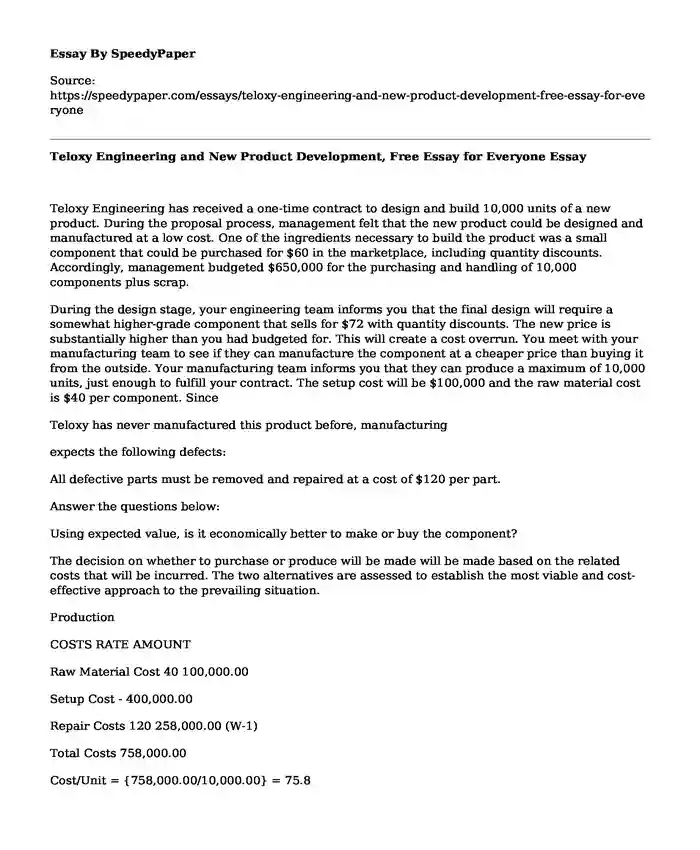
| Type of paper: | Case study |
| Categories: | Engineering Design |
| Pages: | 2 |
| Wordcount: | 464 words |
Teloxy Engineering has received a one-time contract to design and build 10,000 units of a new product. During the proposal process, management felt that the new product could be designed and manufactured at a low cost. One of the ingredients necessary to build the product was a small component that could be purchased for $60 in the marketplace, including quantity discounts. Accordingly, management budgeted $650,000 for the purchasing and handling of 10,000 components plus scrap.
During the design stage, your engineering team informs you that the final design will require a somewhat higher-grade component that sells for $72 with quantity discounts. The new price is substantially higher than you had budgeted for. This will create a cost overrun. You meet with your manufacturing team to see if they can manufacture the component at a cheaper price than buying it from the outside. Your manufacturing team informs you that they can produce a maximum of 10,000 units, just enough to fulfill your contract. The setup cost will be $100,000 and the raw material cost is $40 per component. Since
Teloxy has never manufactured this product before, manufacturing
expects the following defects:
All defective parts must be removed and repaired at a cost of $120 per part.
Answer the questions below:
Using expected value, is it economically better to make or buy the component?
The decision on whether to purchase or produce will be made will be made based on the related costs that will be incurred. The two alternatives are assessed to establish the most viable and cost-effective approach to the prevailing situation.
Production
COSTS RATE AMOUNT
Raw Material Cost 40 100,000.00
Setup Cost - 400,000.00
Repair Costs 120 258,000.00 (W-1)
Total Costs 758,000.00
Cost/Unit = {758,000.00/10,000.00} = 75.8
W - 1
21.5% * 10,000 = 2150
Defect Percentage Probability Cumulative Effect
(A*B)
0% 10% 0%
10% 20% 2%
20% 30% 6%
30% 25% 7.5%
40% 15% 6%
Buying Decision
Costs Rate Amount
Product Cost 72 720,000.00
Handling Cost 50,000.00 (W - 1)
Total Cost 770,000.00
Cost/Unit = 770,000.00/110,000.00 = 77
It is presumed that the costs associated with handling would be fixed and will not be affected by changes in product prices.
(W - 2)
650,000.00 - 600,000 = 50,000.00
From the analysis, it is apparent that the wisest and viable alternative for the company is the production of the product because the cost of purchasing the commodity surpasses that of buying. The low cost of the purchasing decision is primarily contributed by the fixed nature of the cost of handling.
2. Strategically thinking, why might management opt for other than the most economical choice?
For strategic reasons, multiple reasons can make the company to base its decision on other aspects instead of cost. Any business has both short and long-term goals with the underlying objective being profitability and sustainability. Assumed that the aim is to centered on profit-making, it can be argued that the company may be projecting a future increase in demand and reduction in the costs associated with manufacturing. Also, in-house production can result in the decrease in the rate of defective products.
Cite this page
Teloxy Engineering and New Product Development, Free Essay for Everyone. (2022, Mar 14). Retrieved from https://speedypaper.net/essays/teloxy-engineering-and-new-product-development-free-essay-for-everyone
Request Removal
If you are the original author of this essay and no longer wish to have it published on the SpeedyPaper website, please click below to request its removal:
- Essay Example with Music Production Analysis
- Essay Sample with Publicity Campaign Proposal
- Free Essay with a Lab Report Example: Pizza Macromolecules Analysis
- Essay Sample Dedicated to Economic Crisis and Financial Globalization
- Gun Laws in School - Essay Sample for You
- Essay Example: Neoclassical Economics in Relation to Jeremy Bentham's Assertion
- Designing an Intervention. Free Essay
Popular categories




